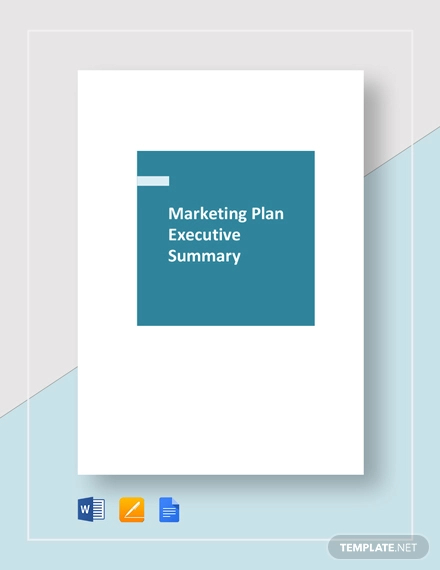Executive Summary of a Marketing Plan Examples to Download
Most business owners probably do not take much time in writing an executive summary of their marketing plan. Something as condensed and skimmed over as the executive summary could not be all that important, right? You could not have been any more wrong. On the contrary, the executive summary of your marketing plan is in fact far more important than the business plan itself.
Marketing Plan Executive Summary

Why, you say?
The executive summary is your elevator pitch. And you have got about a few seconds to sell your business to potential investors.
It is basically the layout of which you intend to do your business. Get it wrong and any investor won’t even bat a curious eye. Get it right and you might just be able to share the vision that you intend your business would be—an opportunity to sell your business to investors. Once you’ve sold your company, it would be easy getting them to invest in the business.

What Is an Executive Summary of a Marketing Plan?
Your executive summary is in the name itself, a summary of the key elements of your marketing plan. It is likened to an orientation tool that gives an interesting overview of your marketing plan, the activities involved, key individuals, etc. As Wikipedia contributors put it:
An executive summary, or management summary, is a short document or section of a document, produced for business purposes, that summarizes a longer report or proposal or a group of related reports in such a way that readers can rapidly become acquainted with a large body of material without having to read it all.
Now more importantly, what are the components of an executive summary?
What Are the Components that Make Up an Executive Summary?
An executive summary is a comprehensive business statement of the overall business proposal or marketing plan. An executive summary should primarily grab the attention of the reader to make them want to read through the proposal or plan itself. To a point, it should contain the following:
1. Overview of the Market

Your market overview should include:
- The size of the market potential – this describes the size and extent of the market where the product is intended.
- The changes within the market – including increase or decrease in the demand
- Segmentation of the market – or how the market is divided; in other words the profile of the market in terms of demographics and behavior, and the benefits of marketing segmentation.
- The identified target market for the business – targets are profiled in terms of what they need from your company and what features and benefits your product offers that meets the need.
- Known competitors for the business – and an overview of the competitors and your analysis of them.
- An overview of the product – a product questionnaire can help you get insights into this.
- Stated goals and objectives of the plan
- The strategies involved in implementing the plan
- Timeline of activities – work schedule of implementation of the plan.
- The method used in gauging the effectiveness of the plan
2. Overview of the Competition

This section involves the summary of key competitors. It describes each strengths and weaknesses in comparison to your product. It essentially provides answers to the following probing questions:
- What are the strengths and weaknesses of your product? This includes SWOT analysis of your product and the competitors.
- What are the competitor products prices?
- What are the noteworthy differences of competitor products and your product?
- Are they promoting other products?
- How are the other products promoted?
- What goals did the competitors set?
- How do they intend to achieve their set goals?
The section focuses on the factors affecting success which largely depend on the nature of your business and the areas it covers such as financial, personnel, engineering, sales, distribution, technology, manufacturing, competitors, life cycles, etc.
3. Overview and Goals of the Product

This section is a descriptive of the measurables that would define success. The description for the particulars or the details regarding your product is next summarized with the following in mind:
- The purpose of the product
- The features that set the standard for the product (key features)
- The structure for the pricing of the product
- Position of the product in respect to the market
- The distribution channels
- What are the advertising tactics and promotions for the product?
- Description of the current packaging of the product
- The goals and objectives meant to be achieved
Your goals are a description of the business plans intended within a year up to five years. Marketing goals then should also be in sync to achieve these goals. Goal definition is important in order to know what your objectives would be and in finding the means of getting to that objective. They should in fact be measurable goals with a timetable (a master schedule) and a forecast of profits which should motivate and challenge your business to do more.
4. Strategies

Developing effective strategies is the next logical step after creating the framework for your goals and objectives to create value for customers.
Creating the right marketing mix aids your business in achieving the goals and objectives that were set. It involves the product itself which focuses on quality of the product, the pricing in reference to market prices, where your product will best be effective, and how the product will be promoted. The right marketing mix that your business decides to implement will be crucial in achieving the goals and objectives that were set in your marketing plan.
5. Plan and Implementation

The action plans and corresponding implementation schedule provides particulars on how you want your business to be marketed. It details the kind of media that you would use whether it be print media, Internet, and others. It would explain why the type of media was chosen including the corresponding marketing budget for each type. Simply put, this section answers what has to be done and who will be the one doing it.
Your action plan, as stated, clarifies your expected costs, revenues, and return on investment. It would also include the controls or measurables that will gauge your progress on your way towards your set goals and objectives.
Writing a Strong Executive Summary
Know your Audience

Creating an executive summary around the expectations of your target audience should at best create immediate interest for potential investors. Selling your brand of business helps attract investors to your cause and knowing what your target wants makes it easier to impress them. The main purpose of an executive summary is to sell. Knowing what to sell to a specific group only raises the advantage of that product to be successful.
Clear Goals
It is important for every executive summary to set a clear understanding of what your product or business has in store for them. Simply stating general goals would not be effective as compared to defining a clear measurable gain at the onset of a proposal. Presenting the results and gains that are quantified by figures presents right away the rewards that await potential investors for the business.
Be Bold
Develop a strong but positive tone in your executive summary. They say that good will never be enough so step away from traditional and focus on strong positioning such as best or finest. This should make a clear distinction of your product from the rest of the typical or normal average brands that any reader would remember or would find hard to forget.
Review
Always reread your executive summary. Check for any spelling errors, improper grammar, etc. You can additionally find others to read and check your document such as your colleagues or friends. Getting comments from another perspective help you find other errors you may have missed.
Summarize
Your executive summary should in all means and purposes be a summary of your business plan or marketing plan. It does not need to include the finer details to the plan. The reader can always go to the plan itself for the particulars. Only the key elements of the plan have to be mentioned and effectively described in your summary.

Short and Concise
Your executive summary at most should be two pages. However, it should describe all the different products in your business—
- how long you have been in business,
- your partners and key personnel,
- structure of your business,
- the goals and objectives of your business, and
- the ways and means that such goals can be attained or achieved.
As always, focus on the main or key points of your business or products.
In conclusion, the executive summary embodies and encompasses everything there is about your business.
It is a clear description of what your business is. It is to serve as a classic and exquisite introduction of your company or business to a target audience or market.
It boasts of your achievements as a company and of your product. It sets clear and measurable goals (i.e., smart goals) in relation to profit forecast and gains.
It serves as eye candy and should considerably attract potential investors to want to help your business for the same reasons of helping themselves.
“Help me help you” is the message an executive summary sends out and together, investor and business, shall achieve the goals and objectives that have been predetermined at the onset of the business relationship.


